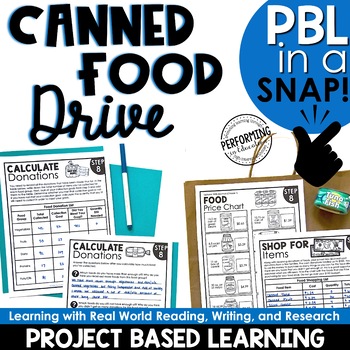Service Learning Project | Canned Food Drive | Community Service | Thanksgiving

What educators are saying
Also included in
- This bundle of 12 cross-curricular project-based learning activities covers math, reading, writing, design, and other skills! Use each project for authentic skill practice or to teach new standards.Save with this bundle that's worth over $78 and keep your students engaged with these fun seasonal proPrice $49.00Original Price $72.00Save $23.00
Description
In this fun Thanksgiving project-based learning (PBL) activity for 4th-6th grades, your students will use key standards in a real-life scenario! These standards include reading comprehension, collaboration, letter writing, decimal (or whole number) operations, and graphing. Differentiation is included!
Driving Question: How can we plan a community service project that will support the members of our community?
⭐️ Digital version included!
This is the perfect November project because you can either run a real food drive at your school, or use a simulated food drive for this project!
Banish worksheets and get your students excited about real life learning! This 5-Day project covers the following skills:
- Research Skills
- Collaboration
- Reading Comprehension
- Letter Writing
- Decimal (or whole number) Operations
- Graphing
- Critical Thinking
- Presentation Skills
Rubric & Sample Answers Included.
Sign up to be notified when I create new project-based learning resources. We always discount them for a limited time, so don't miss out!
**************************************************************************************************************************************************
Copyright © April Smith (Performing in Education). All rights reserved by author. This product is to be used by the original downloader only. Copying for more than one teacher, classroom, department, school, or school system is prohibited. This product may not be distributed or displayed digitally for public view. Failure to comply is a copyright infringement and a violation of the Digital Millennium Copyright Act (DMCA). Clipart and elements found in this PDF are copyrighted and cannot be extracted and used outside of this file without permission or license. Intended for classroom and personal use ONLY.






